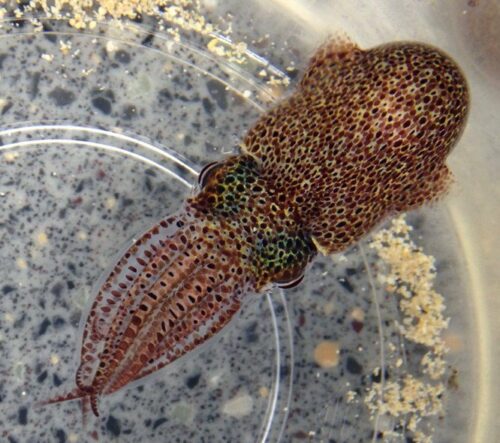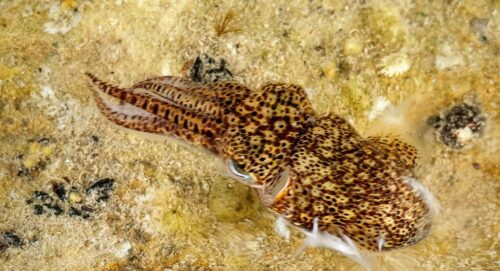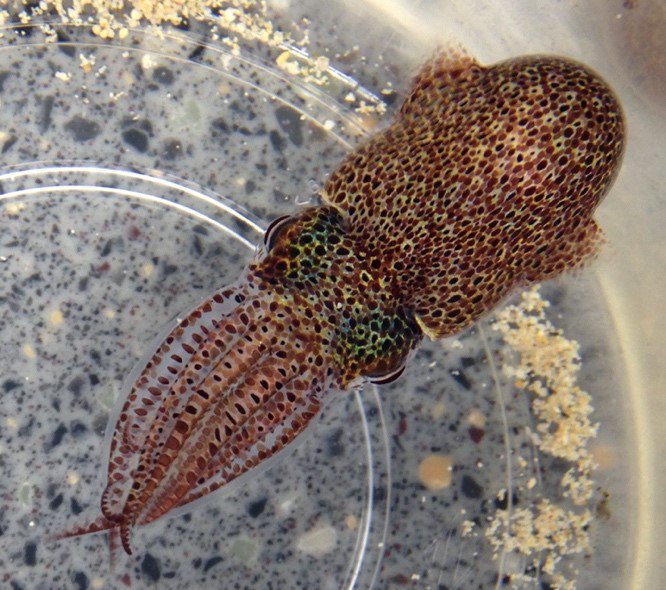New species of bobtail squid discovered
By Steve Reynolds
(STEVE’S SDFSA SCIENCE STORY OF THE MONTH OF AUGUST)
A new species of bobtail squid (genus Euprymna) was recently discovered in Japan. The discovery of a bobtail squid species new to science was made when researchers at the Okinawa Institute of Science and Technology (OIST) “collected three different types of bobtail egg clutches and two types of adults in the shallow waters around the Ryukyu Islands (Okinawa and Yaeyama Islands of the Ryukyu archipelago) in the East China Sea. The eggs were hatched and reared in the laboratory and the DNA of two of the three types of hatchlings matched that of two of the adult animals that were collected at the same time.”

Adult female Euprymna brenneri (the new species of bobtail squid)
(Taken by J.Jolly)
(Source: https://australian.museum/blog/amri-news/pint-sized-perfect-brenners-bobtail/)
Radio transcript regarding the discovery can be heard at https://www.abc.net.au/radio/sydney/programs/self-improvement-wednesday/squid/12413386 . OIST researchers had enlisted the assistance of Dr Mandy Reid from the Australian Museum Research Institute (AMRI). Further details can be found on an Australian Museum blog at https://australian.museum/blog/amri-news/pint-sized-perfect-brenners-bobtail/.
An international collaboration occurred between the AMRI (Dr Mandy Reid) and colleagues from Japan, Austria, and the United States. This resulted in the announcement that a new species of bobtail squid had been discovered. It has been named Euprymna brenneri in honour of Prof. Sydney Brenner. Prof. Brenner was a renowned molecular biologist and Nobel Prize winner who died in 2019. He was one of the founders of the OIST and he had been its president.
The squid, dubbed ‘Brenner’s Bobtail’, was identified as a new species on the basis of its unique morphology and molecular characteristics. It is described in Communications Biology (Sanchez G., Jolly J., Reid A., Sugimoto C., Azama C., Marlétaz F., Simakov O. & Rokhsar D.S. (2019). New bobtail squid (Sepiolidae: Sepiolinae) from the Ryukyu islands revealed by molecular and morphological analysis. Communications Biology. 2: 465. Doi: 10.1038/s42003-019-0661-6) as:
Up to about 22 mm in total body length (excluding the head and arms)
Differs from all other species in the genus because the females have enlarged arm suckers (only the males usually have this trait)
A photo of an adult female Euprymna brenneri, an embryo developing inside an egg and a hatchling (all taken by J. Jolly) can be found at https://australian.museum/blog/amri-news/pint-sized-perfect-brenners-bobtail/.
According to the web page found at https://australian.museum/learn/animals/molluscs/southern-bobtail-squid-euprymna-tasmanica-pfeffer-1884/, Euprymna tasmanica is a close relative of Euprymna brenneri. Euprymna tasmanica is known as either the Southern Bobtail Squid or the Southern Dumpling Squid. According to Allison Runck, “Members of this genus can glue sand grains to their upper body to aid camouflage with their environment”.
In Euprymna tasmanica, “Each arm possesses four rows of suckers, with mature males having enlarged suckers on the inner and outer rows or arms 2-4. A saddle-shaped bacterial light organ* is present inside the mantle cavity. Euprymna tasmanica lives on sand and mud areas, often in association with seagrass beds. They are found up to depths of at least 80m. Distribution (is) Southern Indo-Pacific: found in Australian waters from Brisbane south around to Shark Bay. E. tasmanica emerges at night to forage for crustaceans and fish.
* (“The light organ is used at night to cancel out their silhouette from predators on the seafloor. The organ is filled by luminescent bacteria that are trapped from the seawater by the organ.)
Euprymna species “bury themselves in the seafloor during the day and use their second pair of arms to rake sand grains over (their) head and body. The entire upper surfaces of their skin contain two very special cell types. One acts like a glue, holding a coat of sand over the body- so that even if flushed out of the sand by a predator the sand will remain. The second are special acid cells that can be used to disconnect the entire sand coat at once- leaving it as a sinking decoy for a predator while the squid jets away.
“Spawning typically occurs in spring and summer months when females lay pale orange eggs in loose clumps, usually at the base of seaweeds or seagrass. Hatchlings will quickly settle to the seafloor and bury in the sand. Young hatch without the bacteria needed for their light organ and must obtain this from the water column.”
Details regarding Euprymna tasmanica can also be found on iNaturalist at https://www.inaturalist.org/taxa/151331-Euprymna-tasmanica.
A specimen found by MLSSA member Paul Liew at low tide in the shallow tide pool at the Lady Bay Reef Watch site. Details, including 7 photos (taken by David Muirhead), can be found at https://www.inaturalist.org/observations/39397071.

The specimen found by Paul Liew (Photo taken by David Muirhead)
(Source: https://www.inaturalist.org/observations/39397071)
According to https://www.inaturalist.org/observations/22122384, MLSSA member Dan Monceaux found some in West Lakes in 2019. Details of some that Dan found in the Kingscote tidal pool can be found at https://www.inaturalist.org/observations/9221310.

